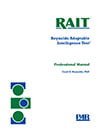
Reynolds Adaptable Intelligence Test rait
For: Assesses crystallised, fluid, and quantitative intelligence in ages 10 to 75 years
Format: Paper-and-Pencil; Online (via PARiConnect)
Length: 50 minutes for full battery; 30 minutes for crystallized and fluid subtests only
Scoring: Hand Scored; Online
Online Forms, Reports, Kits & e-Manuals
All online resources including Forms, Reports, i-Admins, Kits and e-Manuals.
Printed Kits
Click to browse products
Printed Forms & Handscoring Materials
Test forms, response booklets and scoring reference manuals.
Printed Manuals
Physical printed manuals.
RAIT e-Manual (includes Fast Guide e-Manual)
RAIT online Abbreviated Battery Score Report (each) min order 5
RAIT online Abbreviated Battery i-Admin (each) min order 5
RAIT online Score Report (each) min order 5
RAIT online i-Admin (each) min order 5
RAIT Introductory Kit
RAIT Answer Sheets (pack of 25)
RAIT Score Summary Forms (pack of 25)
RAIT Professional Manual (includes Fast Guide)
RAIT Scoring Keys (set of 2)
Sample Reports
Contact PAA today to establish your PARiConnect online account to utilise online administration, scoring and reporting.
Author
Cecil R. Reynolds, PhD
Description
The RAIT is a rapid, reliable, and valid intelligence test designed for group or individual administration. It is composed of seven subtests that assess crystallised intelligence, fluid intelligence, and quantitative aptitude or intelligence.
Features and Benefits
Designed to provide continuity of measurement across a wide age span.
Can be used to help you determine a child’s educational placement and diagnose various forms of childhood psychopathology; as a measure of intelligence in general clinical and neuropsychological evaluations; as part of evaluations for the diagnosis of specific disorders; in disability determinations under various state and federal programs; and as a measure of aptitude in human resources/employment settings.
Requires minimal reading skill and almost no motor coordination and visual-motor skill, reducing the complications that may occur when manipulated objects (e.g., blocks) are used to assess intelligence.
Administration and scoring will be available through PARiConnect; this computer version automatically calculates a measure of effort.
Test Structure
Can be administered to groups or individuals and using a computer or hand scoring. This flexibility makes the RAIT a viable option for use in schools, juvenile and adult justice systems, clinical settings, and human resource and related industrial settings.
Yields a Crystallized Intelligence Index (CII), a Fluid Intelligence Index (FII), a Quantitative Intelligence Index (QII), a Total Intelligence Index (TII), and a Total Battery Intelligence Index (TBII).
Quantitative intelligence subtests are not included in the calculation of the TII, so you can obtain an IQ assessment that does (i.e.TBII) or does not (i.e.TII) include an appraisal of quantitative reasoning skills.
The Score Summary Form allows you to track examinees’ scores over multiple administrations and to calculate reliable change indexes.
Technical Information
The RAIT was standardised on a 2010-Census-matched sample of 2,124 individuals. All formats (i.e., group and individual, booklet and computer) were found to provide common score distributions within the constraints of sampling error.
Subtests are scaled to the T-score metric (i.e., M = 50; SD = 10); indexes are scaled to the IQ metric (i.e., M = 100; SD = 15). Other forms of derived scores, including z scores, normal curve equivalents, stanines, percentiles, and, for the younger ages, age equivalents, are provided.
RAIT scores obtained by individuals in several clinical groups support the validation of the RAIT as a measure of intelligence. These groups included individuals with intellectual disability, TBI, stroke, dementia, learning disability, hearing impairment, and ADHD and those who were considered gifted.
An investigation of RAIT scores’ relationship to examinees’ occupational industries and job complexity levels (as determined by Occupational Information Network [O*NET] Job Zone) revealed expected patterns, with median TBII scores increasing as industry moved from physically-oriented occupations to business-oriented occupations and as job complexity level increased.
The gender bias and ethnic bias of the items were examined rigorously, using multiple methods based on item response theory as well as classical test theory.
Related Products
NB: Prices are in Australian dollars inclusive of GST. NZ customers need to log in to view ex-GST prices.
 NZ
NZ




